Day 2 of a weekend of Summer Tours looking for birds, butterflies and other wildlife. It was mostly bright and sunny this morning, if a little breezy, with more cloud in the afternoon when we had to dodge some showers. Thankfully we managed to stay – mostly – dry.
Our first destination for this morning was up on the heath. As we got out of the minibus, we could hear a Garden Warbler singing in the tall birch trees on one side of the car park. It came a bit closer, into a smaller tree, but all we managed to get were brief glimpses as it moved through the branches before it dropped out of view. Thankfully, a couple of minutes later, it flew round to the blackthorn on the other side of the car park at perched right out in some dead branches in the top, singing.
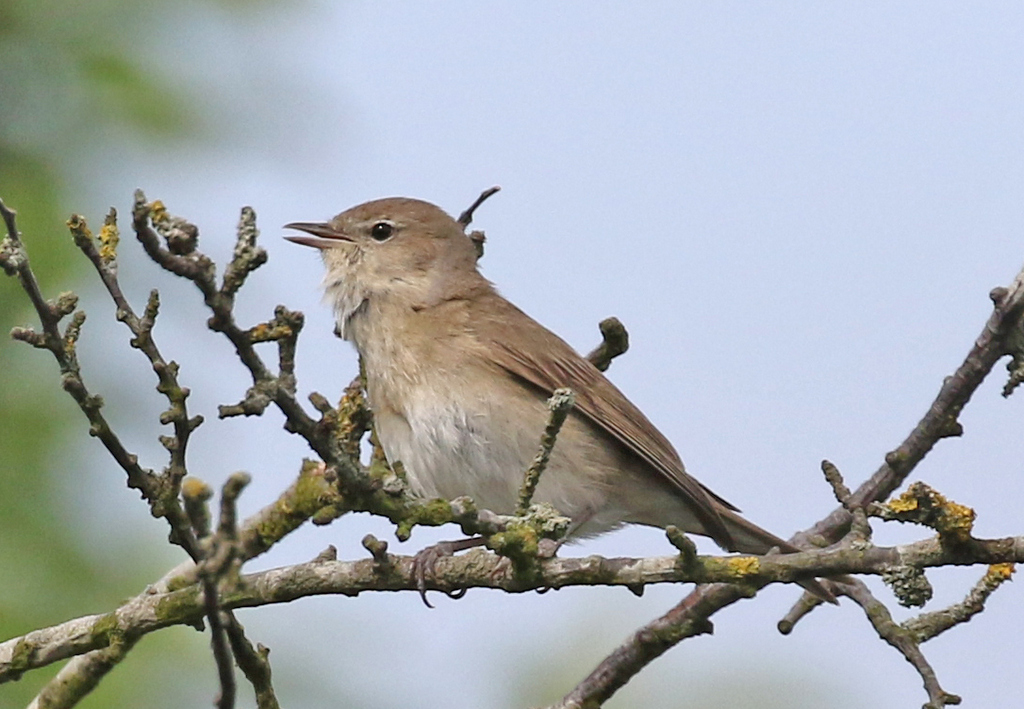
As we walked up the path out onto the heath, we could hear a Yellowhammer singing. A small bird flew up from one of the cut areas ahead of us. It was a Woodlark. It flew up in front of us, then circled round behind – we could see its short tail and broad rounded wings – and we lost sight of it behind the trees.
A little further on, we stopped to look at a male Silver-studded Blue butterfly, a very localised heathland species. They have been slow to emerge this year, probably due to the cold, wet weather over the last week or so, but we would see several out today, in the warmer conditions, including one which appeared to be so newly emerged it was still to be filling out its wings. While we were looking at the Silver-studded Blue, a male Yellowhammer flew up into the top of a small tree nearby.
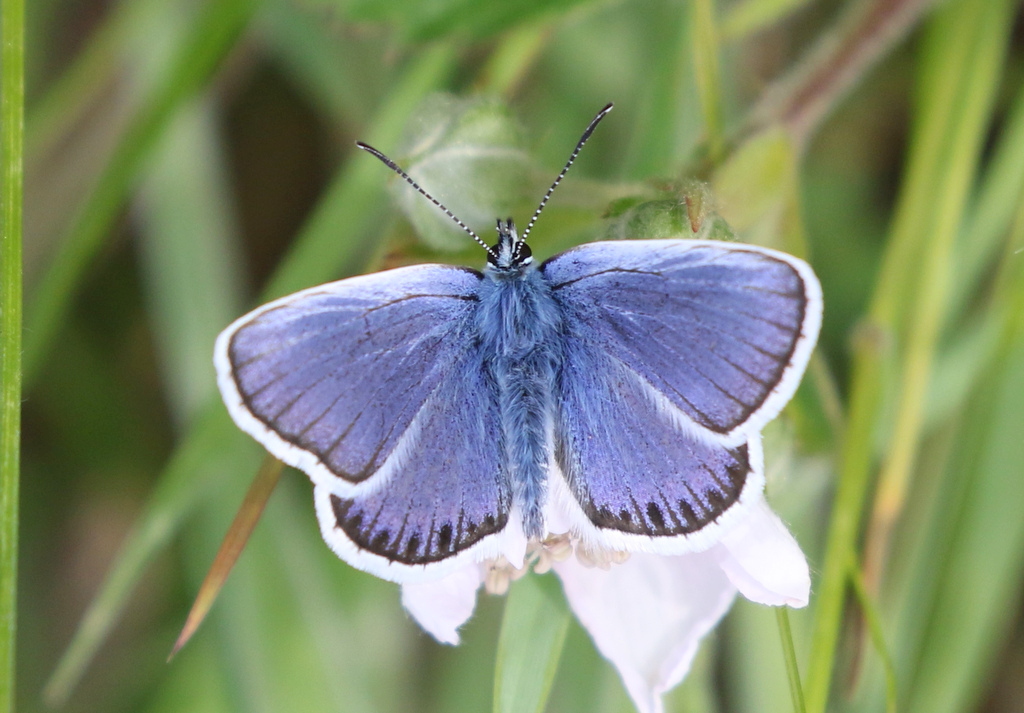
We had a look round a couple of traditional territories where there are usually Dartford Warblers, but we drew a blank. They have been very hard to find in recent weeks – hopefully that just means they have been busy breeding, rather than anything else, although it does look like numbers on the Heath are down again this year, a worrying trend. We did find a family of Willow Warblers calling from some scrubby bushes and saw one of the adults out looking for food in a low birch tree. There were several families of Linnets in the gorse too.
On our travels, we also came across an Adder basking on the edge of the gorse which slithered quickly in when we stopped to look at it. A Common Lizard ran through the heather too. There were several Painted Lady butterflies out again today, and we found one or two July Belle moths which flushed from the heather beside the path.
We decided to try our luck on another part of the Heath and as we made our way round, we happened to notice a shape on top of a dead stump not far from the path. It was a roosting Nightjar! It opened one eye and looked at us as we set up the scope on it, but was obviously relying on its fantastic camouflage to assume we couldn’t see it. We took it in turns, one at a time so as not to create too much disturbance, to look at it. Fantastic!

After enjoying the sound of Nightjars churring last night, and watching them flying round above our heads in the twilight, it was great to see one in daylight today and admire its cryptic plumage. A real bonus as we rarely find them perched out in the daytime.
There were one or two more Silver-studded Blue butterflies out on the other side of the Heath. We found a pair of Stonechats here too, the male and female both alarm calling and collecting food, suggesting they may have a nest somewhere close with young in it. A Common Whitethroat flew up in a song flight and a Coal Tit worked its way through the gorse. Several Common Buzzards started to circle up and we watched two chasing each other above the trees. But we couldn’t find any Dartford Warblers over here either, so we decided to head back.
On the way, we stopped to look at a flowering bush that was covered in butterflies – at least 12 Painted Ladys and several Red Admirals. As we walked through a group of pine trees, we could hear a Goldcrest singing and we looked up to see it flitting around in the branches. Back at the car park, the Garden Warbler was still singing.
Moving on, we dropped down to the coast at Cley, stopping at the Visitor Centre briefly to use the facilities before driving round to Walsey Hills. There were several Common Pochard on the pool at Snipe’s Marsh, including a female with seven small ducklings. Common Pochard is a scarce breeding bird in the UK, so it is always good to see successful breeding.
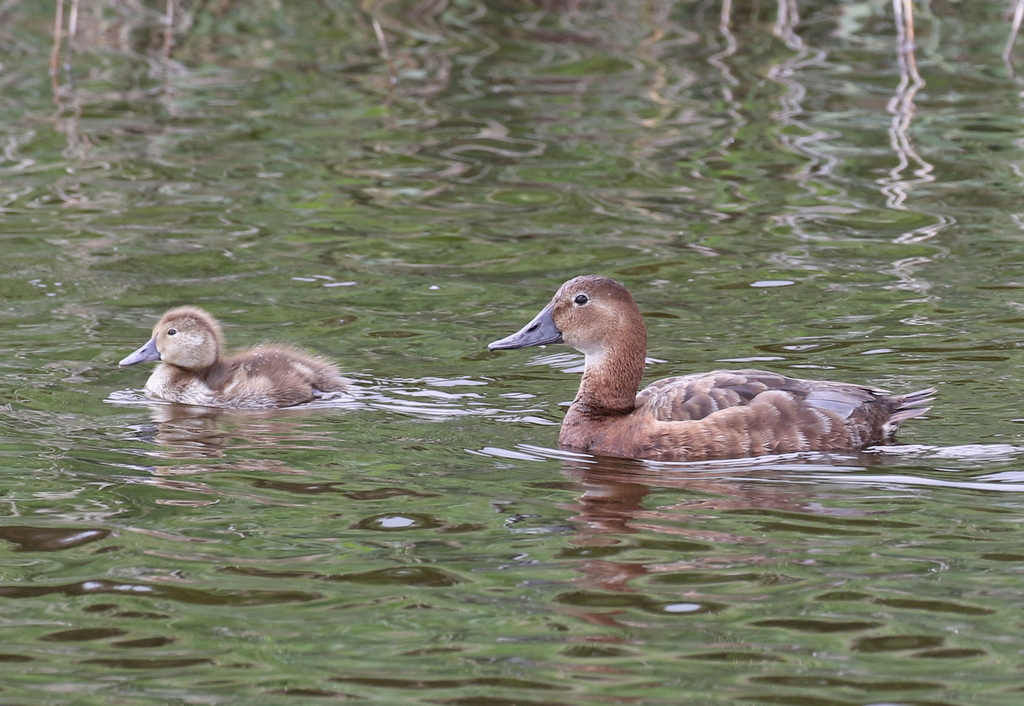
We could see a Spoonbill feeding in the Serpentine further out along the East Bank, so we walked out to have a look at it. There were several Reed Warblers singing in the reeds and a Reed Bunting perched up in a small elder in the reedbed. We heard a Bearded Tit calling and caught a glimpse of it zooming off over the reeds, but it was a little breezy for them out here today.
There were lots of Greylag Geese out on the grazing marshes, along with four Curlew, early returning birds, possibly failed breeders or non-breeders. There were several Shelduck on Pope’s Pool. A pair of Avocet had nested on the bare mud here and had two small juveniles – balls of grey fluff with long legs and a short, slightly uptilted bill. A Lapwing was still on the nest. A Little Ringed Plover appeared briefly on an area of short muddy grass.
The Spoonbill was busy feeding further back in the water, where it was hard to see, but now flew over to the far northernmost corner. We could see it better here and we watched it walking round with its head down, sweeping its bill from side to side through the shallow water. Occasionally it would flick its head up when it caught something. It worked its way back towards us along the grassy edge and came right past along the edge of the Serpentine. We could see the yellow tip to its black bill and its shaggy crest, a breeding adult.

A second Spoonbill was hidden down in a smaller low pool behind the bank at the back, but obviously encountered the ire of a pair of Avocets, which chased it out. It joined the first Spoonbill on the Serpentine for a bit, before deciding the coast was clear and heading back to the pool where it had been feeding before.
Continuing on to Arnold’s Marsh, past the main drain where a Little Grebe was diving, we went into the shelter to get out of the wind. There were lots of Sandwich Terns packed in on one of the small islands and others bathing and preening further over. Through the scope we could see their yellow-tipped black bills and shaggy crests. A single Common Tern was loafing nearby – noticeably different, with its black-tipped red bill and red legs, and its smooth black crown.
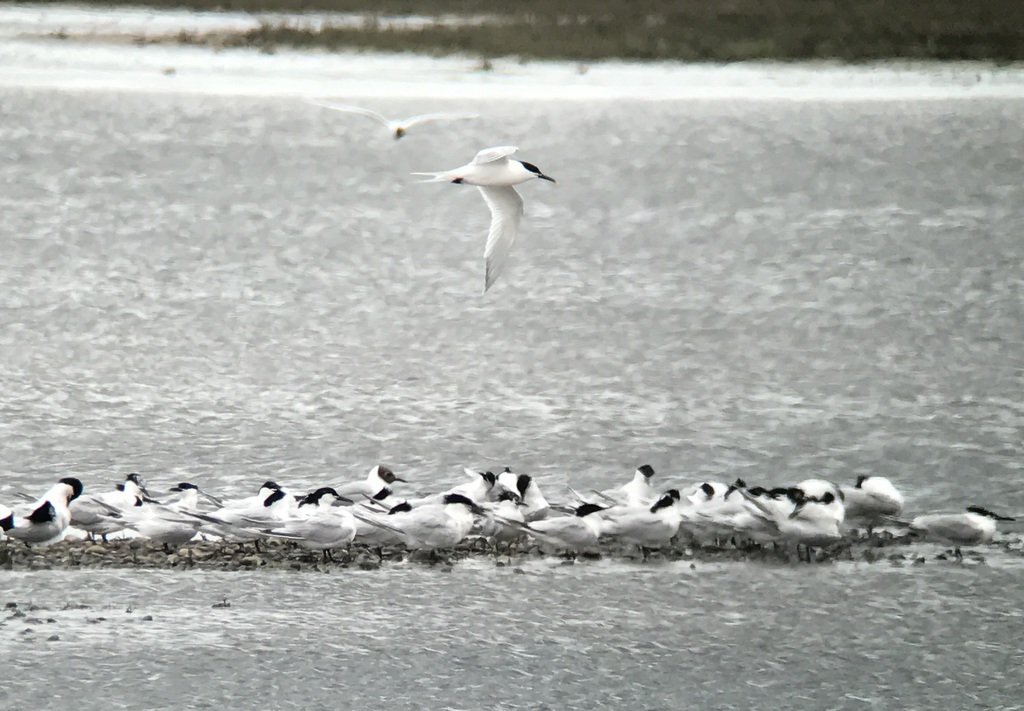
Scanning around the edges of Arnold’s Marsh, we found a Little Gull right over at the back. It was a young one, in its first summer, with a non-breeding black spot behind its eye and small black cap. We had a look at it through the scope, before it walked back into the vegetation and went to sleep. Otherwise, there were a few Redshanks on here today but no other waders.
We couldn’t come this far and not at least have a quick look at the sea. There were several Sandwich Terns feeding just offshore, plunge diving into the surf after fish, and we found at least six Little Terns in with them too. They were tiny by comparison, with black-tipped yellow bills and white foreheads.
It was time for lunch now, so we walked back along the East Bank to Walsey Hills. It was spitting with rain when we got back to the minibus, as a dark cloud passed over, but we could see bright blue sky approaching from the south-west. We sat down at the picnic tables by the visitor centre, in the light rain, but our faith was vindicated as the sun promptly came out again. A few Sand Martins skimmed back and forth low over the reeds.
We set the scope up here and scanned Pat’s Pool over lunch. There were some Black-tailed Godwits feeding in the shallow water, and we found another Little Gull swimming over by the reeds, picking insects from the surface of the water. Next time we looked back there were a load more waders which had just flown in. Through the scope, we could see they were mainly Bar-tailed Godwits, about 80 of them, along with 20 Knot. They were mostly in non-breeding plumage, but we did get a smart rusty breeding adult Bar-tailed Godwit in the scope, next to a breeding plumage Black-tailed Godwit for comparison.
After lunch, we headed west along the coast to Wells. We could see dark clouds ahead of us, but the worst of them seemed to be heading out to sea. When we got to Wells however, we could see there were more dark clouds heading our way. We got out and had a quick look at the pools. We could see a couple of Spoonbills over towards the far side, so we set off down the track. A couple of Sedge Warblers were singing along the edges of the ditches either side and two Yellowhammers flew in landed in a bush right next to the path.
From somewhere in the vegetation beside the path ahead of us, a House Sparrow flew out and caught a dragonfly (a Four-spotted Chaser) in mid air. It landed on the track with it and we watched it shaking it to dismember it, detaching the wings first and then breaking the abdomen into bite-sized chunks.
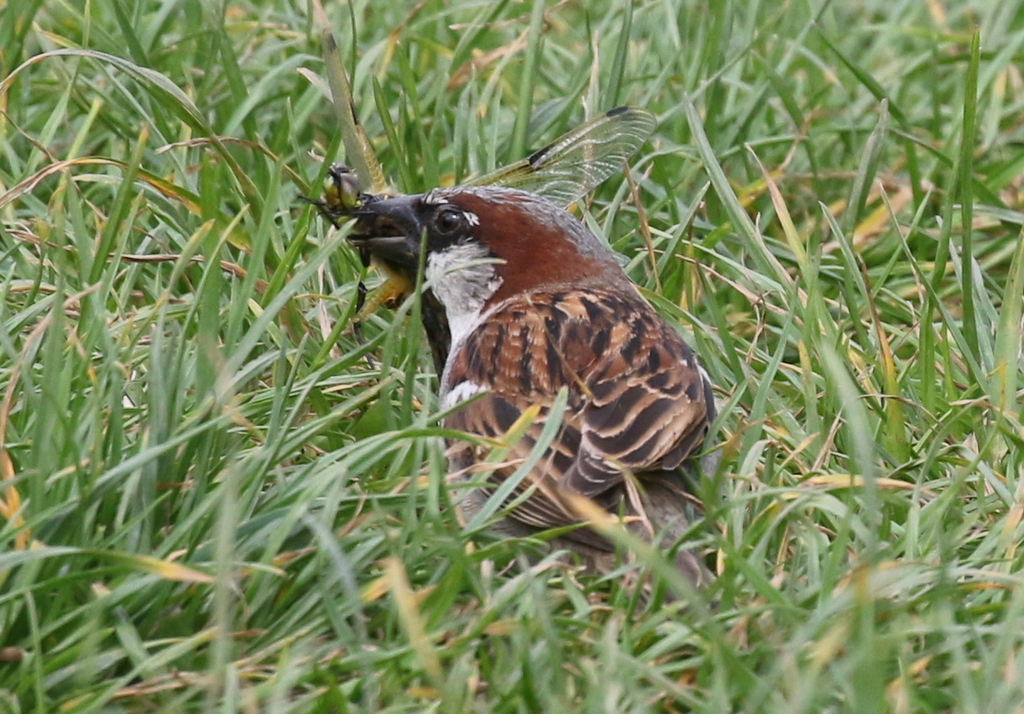
It was becoming increasingly clear we would not escape the rain and as it started spitting we beat a hasty retreat to the minibus, just in time before the heaven’s opened. A quick check revealed there was a narrow bank of rain coming in from the west, so we decided on a quick change of plan. We drove west to Titchwell instead, coming out of the rain on our way there.
As we walked down the path to the Visitor Centre, it was clear it had just rained very heavily here based on the big puddles. A Blackcap was singing in the trees above the path and a flock of Long-tailed Tits was working its way through the sallows.
As we walked out along the main path beside the reedbed, we could hear Reed Buntings and Reed Warblers singing. Bearded Tits were zooming back and forth over the tops of the reeds but not perching up today. Several Marsh Harriers were circling over towards the back. A Great Crested Grebe was swimming in and out of the reeds in one of the channels. Several Swifts and House Martins were hawking for insects over the reeds.
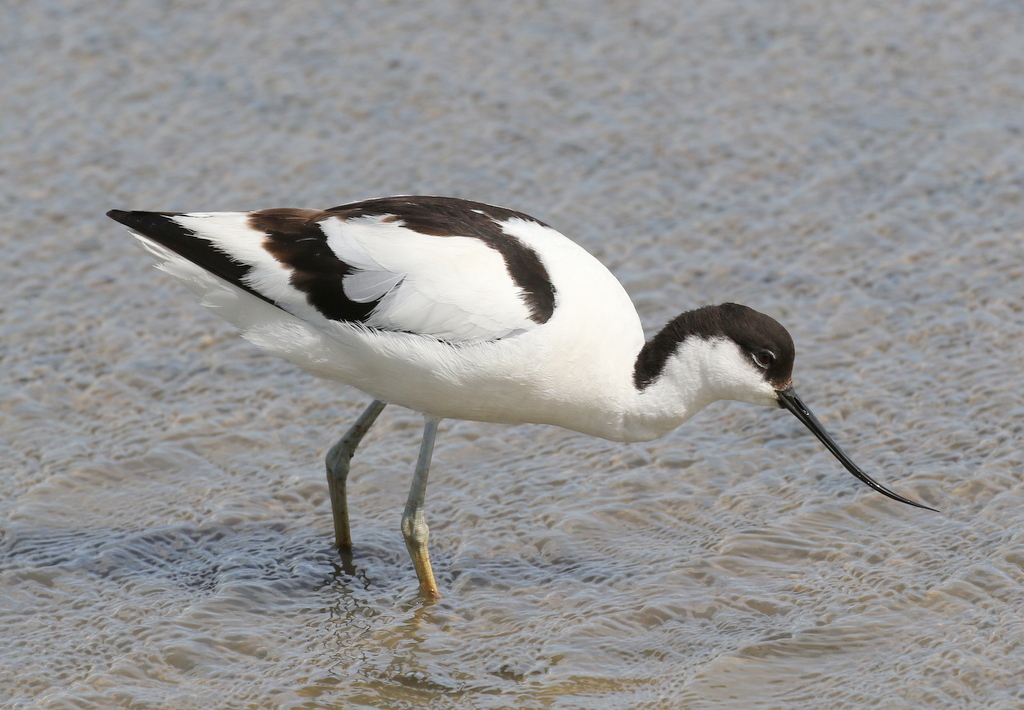
Out at Island Hide, there were several Avocets feeding in the shallow water in front of the hide. A flock of twenty four Bar-tailed Godwits, together with two Knot and two Black-tailed Godwits were roosting out in the middle. We really wanted to see the Spotted Redshanks which had been on the Freshmarsh earlier, but we couldn’t find any sign of them from here.
The number of Teal on the Freshmarsh is already increasing again, as birds return early from their breeding grounds on the continent. Otherwise, there was the regular selection of Shelduck, Shoveler, Gadwall and Mallard on here. The Freshmarsh is still dominated by gulls, which have taken over ‘Avocet Island’ to nest. We managed to pick out our first Mediterranean Gulls amongst the massed ranks of Black-headed Gulls. Ironically, the Mediterranean Gulls’ blacker hoods set them apart! There were one or two Common Terns in with the gulls too.
As we made our way round to Parrinder Hide, there was a great commotion in the gull colony, as everything flew up calling. A Marsh Harrier had flown in over the island and we watched it drop down and grab a juvenile Black-headed Gull. It took off again and flew off over the bank at the back, pursued by a mob of angry gulls. Nature in the raw!
From round at Parrinder Hide, everything had settled down again. We had an even better view of the Mediterranean Gulls from here, with several loafing in with all the Black-headed Gulls on the islands in front of the hide. As well as their blacker hoods, we could see their contrasting white eyelids, brighter red bill and white wing-tips.
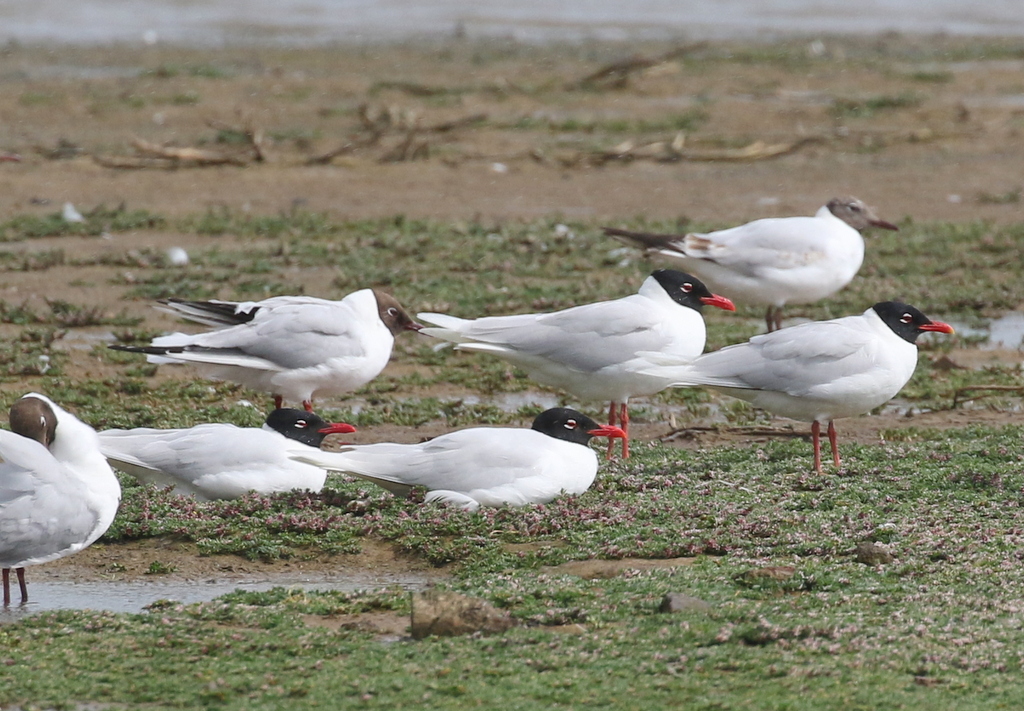
We could see the Spotted Redshanks from here, two of them right over in the far corner of the Freshmarsh by the reeds. Through the scope, we got a better look at them, still in their jet black breeding plumage peppered with silvery white spots on their wings. These are either failed breeders or the first returning females, which leave the males behind to take on childcare duties! Smart birds when they first return, they will now quickly moult into grey non-breeding plumage. Two Little Ringed Plovers flew across in front of the hide and landed on the island out to the right.
The gulls in the breeding colony were nervous, and there was one false alarm when part of the island started to erupt before settling back down again. Then the Marsh Harrier came in again and everything went up. We watched it drop down into the vegetation on the island through the mass of white gulls. It came up with a juvenile Black-headed Gull in its talons again and flew off towards the bank, despite a frenzied attack from several of the adult gulls diving at it. The Marsh Harrier had obviously realised it was worth undergoing the attacks for the reward of Black-headed Gull chicks.
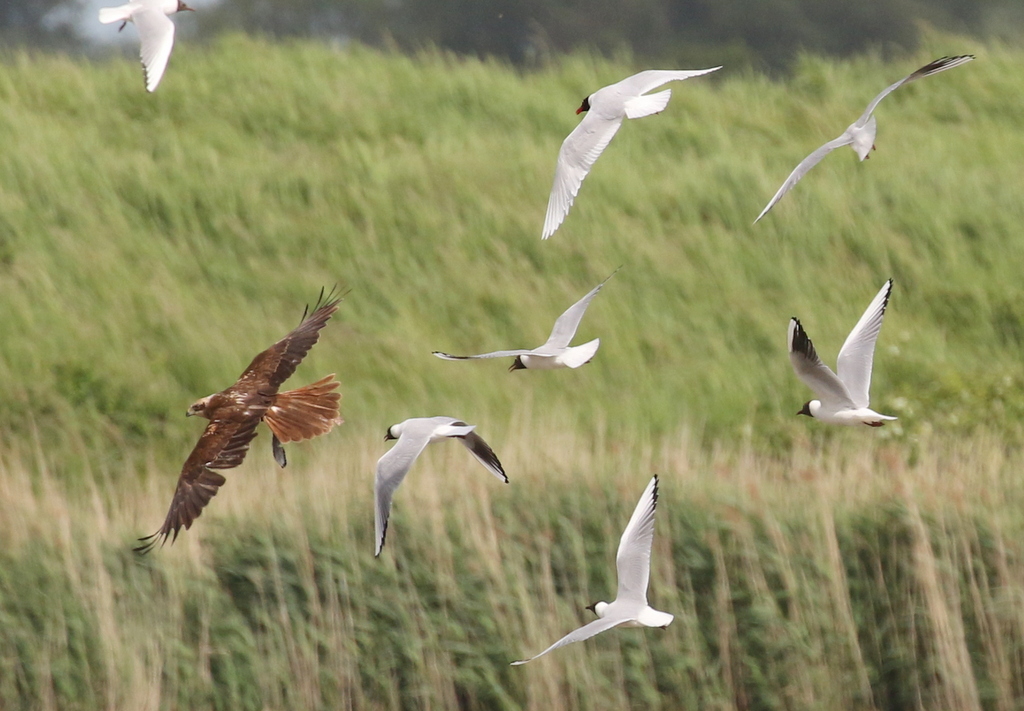
We wanted to have a quick look in at Patsy’s Reedbed before the end of the day, so we set off on our way back. Up on the main path, we noticed a Spotted Redshank had just dropped in down just below the bank. We had a great view of it here, but it was not happy with all the people walking on the bank and quickly flew off again as some people approached from the other direction. As our summer is (hopefully!) just beginning, it is amazing to think that their summer is over already. Autumn wader migration is here!
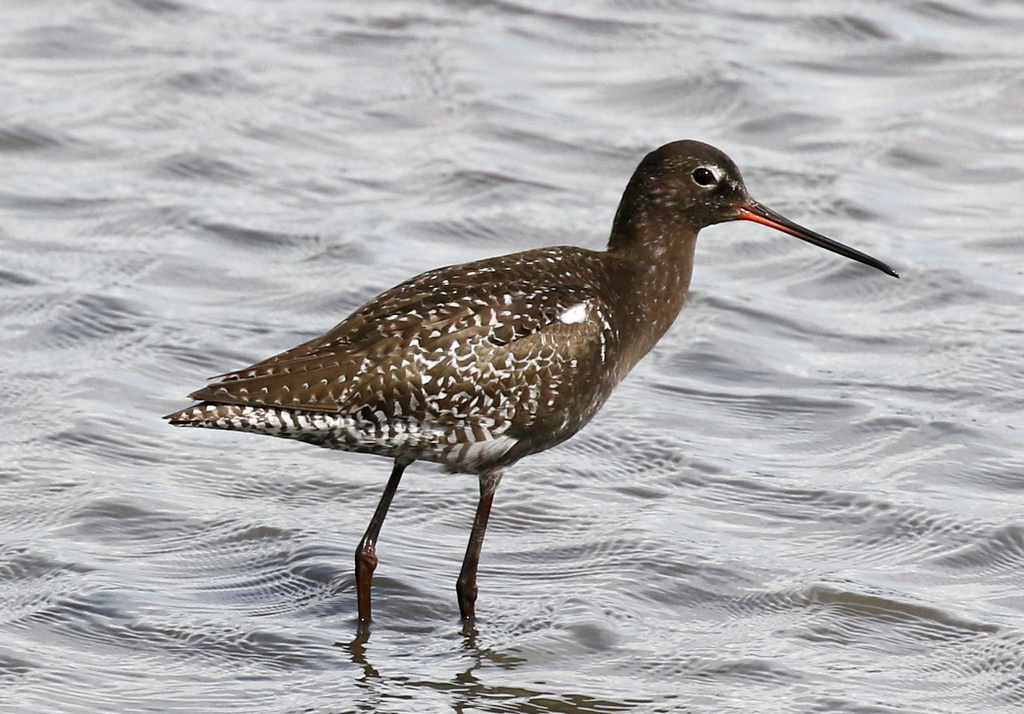
Round at Patsy’s Reedbed we could see a small crowd gathered by barrier at the end of East Trail. There has been a Purple Heron in the area for some time. It had disappeared for a week, but reappeared again earlier today. It hadn’t been seen for several hours though, but we kept one eye on the reeds over there just in case, while we scanned the pool.
There were several Red-crested Pochard on the pool – two drakes starting to moult out of their bright breeding plumage, and one already in female-like eclipse plumage with its coral-red bill giving it away, plus a single female. A Little Grebe was lurking in the edge of the reeds down at the front and several Mediterranean Gulls were bathing out in the middle with a larger flock of Black-headed Gulls.
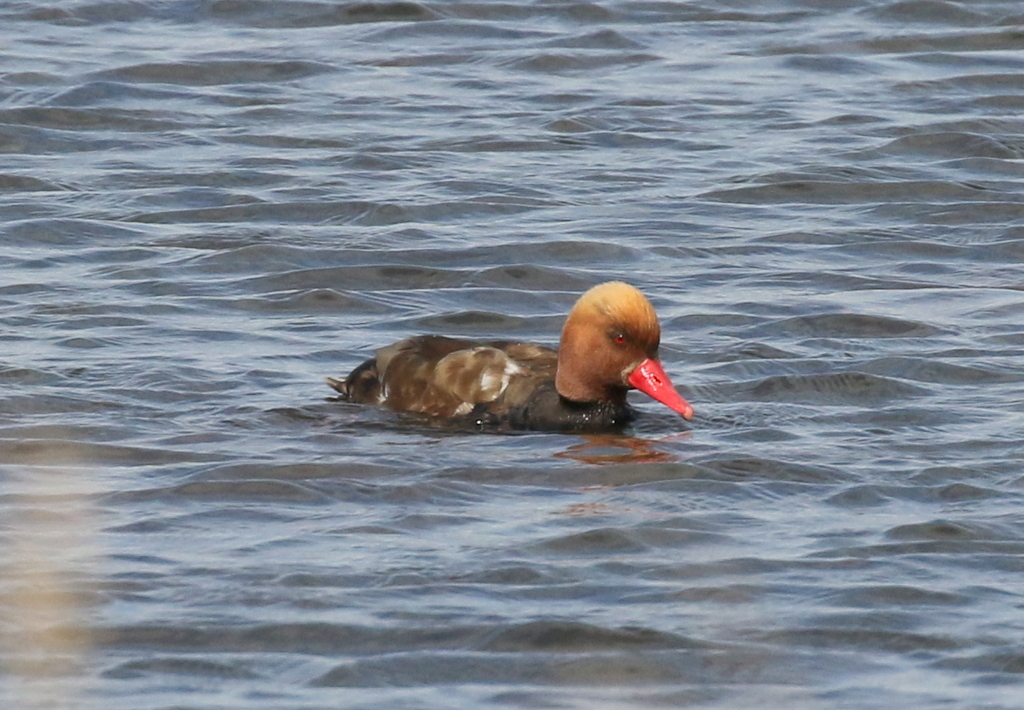
One or two Marsh Harriers circled over the reedbed beyond. A Lesser Whitethroat was singing in the hedge behind us. They typically go quiet when they are breeding and then start singing again before they have a second brood, so this one has probably just finished raising its first.
Then unfortunately it was time for us to head back. A male Sparrowhawk was a late addition to the list as we drove home, skimming the top of the tarmac ahead of us before diverting into a garden beside the road and landing on a fence. It had been a great weekend, with a nice selection of birds and other summer wildlife, with some memorable moments.
















